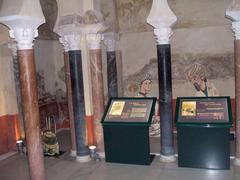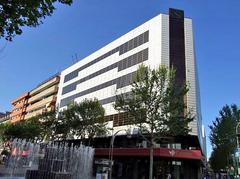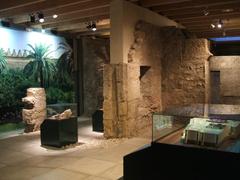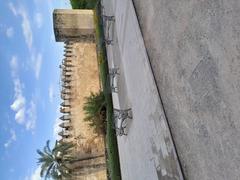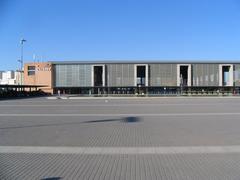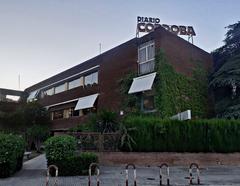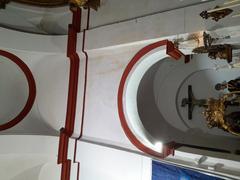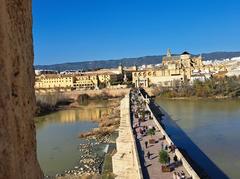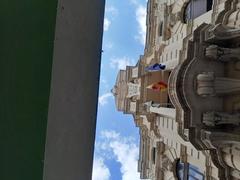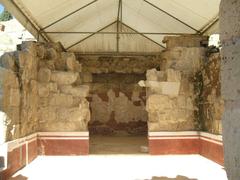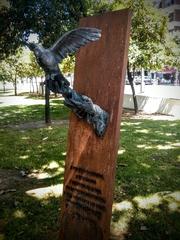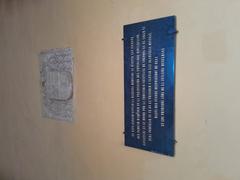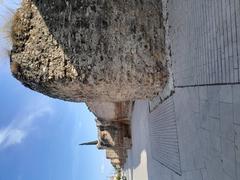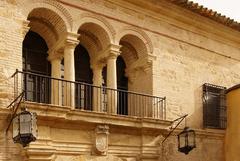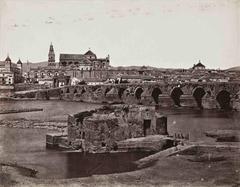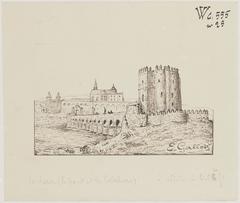Visiting the Bust of Al-Gafequi in Córdoba, Spain: Tickets, Hours, and Tips
Date: 14/06/2025
Introduction
Córdoba, a jewel of Andalusia, is celebrated for its rich tapestry of history, art, and scientific progress, especially during the Islamic Golden Age. Among its most illustrious figures is Muhammad ibn Qassoum ibn Aslam Al-Gafequi, a 12th-century ophthalmologist whose legacy is immortalized by a striking bronze bust in Plaza del Cardenal Salazar, at the heart of the city’s Jewish Quarter. This guide offers a detailed exploration of Al-Gafequi’s life and achievements, practical information for visiting the monument, and tips to enhance your experience as you discover Córdoba’s intellectual and multicultural heritage.
For further details, images, and virtual resources, see (Explorial), (artencordoba.com), (Official Córdoba Tourism).
Historical Context: Córdoba and Al-Andalus in the 12th Century
During the 12th century, Córdoba thrived as a center of learning and scientific advancement under Islamic rule, attracting scholars from across the Mediterranean. Libraries, universities, and hospitals flourished, making the city a beacon for intellectual exchange between Muslims, Christians, and Jews (Explorial). Medical practitioners accessed a wealth of translated knowledge from Greek, Roman, Persian, and Indian sources, propelling medicine to new heights (Wikipedia).
It was in this vibrant cultural context that Al-Gafequi rose to prominence, exemplifying the spirit of scientific inquiry and cross-cultural collaboration that defined Córdoba’s golden era.
Biography of Al-Gafequi
Early Life and Education
Born in Gafeq (present-day Belalcázar, near Córdoba) in the late 11th or early 12th century (es.wikipedia), Al-Gafequi was shaped by Córdoba’s intellectual environment and deepened his medical knowledge in Baghdad. This cross-cultural education influenced his approach to medicine and innovation.
Medical Achievements and Innovations
Specializing in ophthalmology, Al-Gafequi became renowned for advanced diagnosis and treatment of eye diseases, especially cataracts—a leading cause of blindness in the medieval world. He was among the first to perform documented cataract surgeries, designing specialized needles for the procedure and engaging in scientific debate with contemporaries like Albucasis (The Romantic Traveller). His empirical extraction of cataracts in their membrane was a milestone in surgical technique.
Al-Gafequi also pioneered the use of pain relief during operations, challenging the prevailing notion that pain was a necessary part of healing. His compassionate approach marked a significant advance in patient care (The Romantic Traveller).
Scholarly Works and Legacy
His most significant work, the “Guía del oculista” (Kitāb al-Murshid fi’ l-kuḥl), synthesized ancient and contemporary knowledge with his own clinical innovations. The treatise, preserved in the Monastery of El Escorial and in Cairo, systematizes ocular anatomy, disease diagnosis, surgical procedures, and pharmacology (en.wikipedia, es.wikipedia). Al-Gafequi’s influence extended beyond Al-Andalus through Latin and Hebrew translations that shaped European ophthalmology (Explorial).
The Bust of Al-Gafequi: Commemoration and Artistic Features
Location and Setting
The bronze bust of Al-Gafequi is prominently displayed in Plaza del Cardenal Salazar, within the Jewish Quarter (Judería). It faces the former Hospital del Cardenal Salazar, now the Faculty of Philosophy and Letters of the University of Córdoba—creating a symbolic link between historical and contemporary knowledge (artencordoba.com).
Artistic Description
Commissioned in 1965 to mark the 800th anniversary of Al-Gafequi’s birth, the bust was sculpted by Miguel Arjona Navarro. Crafted in bronze and mounted on a stone pedestal inscribed with the physician’s achievements, the monument depicts Al-Gafequi in a contemplative pose, dressed in 12th-century Andalusian attire. The realistic features—the high forehead, deep-set eyes, and turban—evoke scholarly wisdom and the timeless pursuit of knowledge (artencordoba.com).
Symbolism and Cultural Significance
The monument is not only a tribute to an individual but also stands as a testament to Córdoba’s multicultural heritage. It complements other monuments in the city dedicated to figures like Maimonides and Seneca, reinforcing the city’s tradition of honoring intellectual and scientific contributions (amedinacordoba.com). The bust’s location in a peaceful plaza surrounded by whitewashed buildings and cobblestone streets invites reflection on Córdoba’s role as a hub of medical innovation.
Visiting the Bust of Al-Gafequi: Practical Information
Location and Getting There
- Address: Plaza del Cardenal Salazar, Córdoba, Spain
- Public Transport: Bus lines serve the city center; alight at ‘Plaza de las Tendillas’ and walk 10 minutes to the plaza (Evendo).
- By Car: Parking in the historic center is limited; use public lots and walk to the site (Evendo).
Visiting Hours and Tickets
- Open 24/7: The monument is in a public space and accessible at all hours.
- Entry Fee: Free—no ticket required.
Accessibility
- The plaza and surrounding streets are wheelchair accessible, though some cobblestones may be uneven. The area is pedestrian-friendly and features benches and shade (The Crazy Tourist).
Guided Tours
- Many walking tours of the Jewish Quarter include the bust as a highlight. These tours often cover other key sites like the Mezquita-Catedral and the Synagogue of Córdoba (Official Córdoba Tourism).
Best Time to Visit
- Spring (March–May) and Autumn (September–November): Offer the most pleasant weather and coincide with vibrant festivals such as the Patios Festival (Siente Córdoba), (TravelPander).
- Evening: The bust is illuminated after dark, creating a dramatic effect for photography.
Nearby Attractions
- Mezquita-Catedral: Iconic mosque-cathedral, UNESCO World Heritage Site (Siente Córdoba).
- Synagogue of Córdoba: One of Spain’s best-preserved medieval synagogues.
- Alcázar de los Reyes Cristianos: Fortress with gardens and historical exhibits.
- Plaza de la Corredera: Lively square for local cuisine and people-watching.
- Patios de Córdoba: Celebrated in May with stunning floral displays (TravelPander).
Visitor Experience and Tips
- Photography: Early morning or late afternoon light enhances the bust’s bronze features.
- Comfort: Wear comfortable shoes for exploring the cobbled streets of the Judería.
- Combine Visits: Include the bust in a walking itinerary featuring the Jewish Quarter’s other historic sites.
- Engage Locally: Support local artisans and cafes nearby.
- Respect: Avoid climbing or touching the monument; be considerate of other visitors.
Special Events and Cultural Activities
Throughout the year, the Jewish Quarter hosts festivals such as the Patios Festival and Holy Week processions, enriching the experience of visiting the bust. Occasional educational programs and guided tours focus on Córdoba’s scientific legacy (Official Córdoba Tourism).
Frequently Asked Questions (FAQ)
Q: What are the visiting hours for the Bust of Al-Gafequi?
A: The monument is in a public plaza and accessible 24/7, free of charge.
Q: Is there an entrance fee or ticket required?
A: No, visiting the bust is completely free.
Q: Are guided tours available?
A: Many walking tours of the Jewish Quarter include the bust; check with local tourism offices.
Q: Is the site wheelchair accessible?
A: Yes, though some cobblestones may be uneven; assistance may be helpful.
Q: What other historical attractions are nearby?
A: The Mezquita-Catedral, Synagogue, Alcázar, and Plaza de la Corredera are all within walking distance.
Q: What is the best time of year to visit?
A: Spring and autumn, when the weather is mild and cultural events abound.
Visuals and Media
High-quality images and virtual tours are available on (Explorial) and other tourism websites. Optimized alt text such as “Bust of Al-Gafequi statue in Córdoba” helps improve accessibility and searchability.
Conservation and Legacy
Córdoba’s municipal authorities regularly maintain the monument, ensuring its preservation as a symbol of the city’s dedication to honoring historical figures and fostering cross-cultural understanding (artencordoba.com). The bust remains a focal point for visitors, students, and locals, embodying the enduring relevance of Al-Gafequi’s contributions to medicine and science.
Conclusion
The Bust of Al-Gafequi is more than a monument—it is a gateway to Córdoba’s legacy as a crucible of medical innovation and multicultural exchange. Its accessible location, artistic merit, and historical resonance make it an essential stop for anyone seeking to understand the city’s layered past. Plan your visit to coincide with Córdoba’s lively festivals, join a guided tour for deeper insights, and take a moment to reflect on the enduring impact of knowledge, empathy, and cross-cultural dialogue in shaping our world.
For up-to-date information, event calendars, and personalized itineraries, download the Audiala app and follow official Córdoba tourism channels.
Sources and Further Reading
- Explorial: Córdoba Estatua de Al-Gafequi
- artencordoba.com: Esculturas en las Plazas de Córdoba – Mohamed Al-Gafequi
- Official Córdoba Tourism: Al-Gafiqi o Al-Gafeqi
- Evendo: Estatua a Mohamed Al-Gafequi
- Wikipedia: Muhammad ibn Aslam Al-Ghafiqi
- es.wikipedia: Mohamed Al-Gafequi
- The Romantic Traveller: One in the Eye in Córdoba
- Siente Córdoba – Monuments Guide
- The Crazy Tourist: 15 Best Things to Do in Córdoba
- TravelPander: Where is Córdoba, Spain Located?
- amedinacordoba.com: Al-Gafequi
- GoNOMAD: Córdoba, Cultural Center Through the Centuries
- Spain.info - Córdoba Destination
